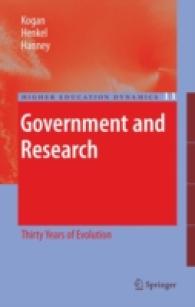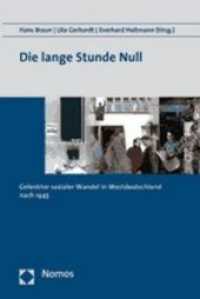- ホーム
- > 洋書
- > 英文書
- > History / World
Full Description
How was violence justified in early Islam? What role did violent actions play in the formation and maintenance of the Muslim political order? How did Muslim thinkers view the origins and acceptability of violence? These questions are addressed by an international range of eminent authors through both general accounts of types of violence and detailed case studies of violent acts drawn from the early Islamic sources. Violence is understood, widely, to include jihād, state repressions and rebellions, and also more personally directed violence against victims (women, animals, children, slaves) and criminals. By understanding the early development of Muslim thinking around violence, our comprehension of subsequent trends in Islamic thought, during the medieval period and up to the modern day, become clearer.
Contents
1. Violence, Our Inherent Heritage: Introduction, Istvan T. Kristo-Nagy and Robert Gleave
Section I. Jihaad and Conquest: Attitudes to Violence against the External Enemies of the Muslim Community
2. The Question of Divine Help in the Jihad, Dominique Urvoy3. Reading the Qur'an on jihad: two early exegetical texts, Andrew Rippin4. Ibn al-Mubarak's Kitab al-Jihad and early renunciant literature, Christopher Melchert5. Shaping Memory of the Conquests: The Case of Tustar, Sarah Bowen Savant
Section II. The Challenged Establishment: Attitudes to Violence against the State and in its Defence within the Muslim Community
6. Who Instigated Violence: A Rebelling Devil or a Vengeful God?, Istvan T. Kristo-Nagy7. Attitudes to the use of fire in executions in late antiquity and early Islam: the burning of heretics and rebels in late Umayyad Iraq, Andrew Marsham8. 'Abbasid State Violence and the Execution of Ibn 'A'isha, John A. Nawas9. The Sultan and the Defiant Prince in Hunting Competition: Questions of legitimacy in hunting episodes of Ṭabaristan, Miklos Sarkozy
Section III. Lust and Flesh: Attitudes to Violence against the Defenceless, Intra-Communitarian Violence by Non-State Actors
10. Violence against Women in Andalusi Historical Sources (third/ninth-seventh/thirteenth centuries), Maribel Fierro11. Sexual Violence in Verse: The Case of Ji'thin, al-Farazdaq's sister, Geert Jan van Gelder12. Bandits, Michael Cooperson13. Eating People Is Wrong: Some Eyewitness Accounts of Cannibalism in Arabic Sources, Zoltan Szombathy14. Animals Would Follow Shafi'ism: Legitimate and illegitimate violence to animals in Medieval Islamic Thought, Sarra Tlili
BibliographyIndex








